Sarah Sundin's Blog, page 50
June 22, 2024
Today in World War II History—June 22, 1944

Pres. Franklin Roosevelt signs the G.I. Bill in the Oval Office, with (l to r) Bennett “Champ” Clark, J. Hardin Peterson, John Rankin, Paul Cunningham, Edith Rogers, J.M. Sullivan, Walter George, John Stelle, Robert Wagner, (unknown), and Alben Barkley; June 22, 1944 (FDR Library: NPx 64-269)
80 Years Ago—June 22, 1944: President Roosevelt signs GI Bill of Rights.
Soviets launch Bagration offensive in Byelorussia, which will lead to the heaviest German losses in the war (nearly 500,000 men).
In India, British and Indian troops open the Imphal-Kohima Road, breaking the siege of Imphal.
US Northrop P-61 Black Widow night fighter is first flown in combat, from Saipan.
Danish resistance group BOPA destroys Riffelsyndikatet arms factory in Copenhagen.

Gurkha troops on the Imphal-Kohima Road, 1944 (US Library of Congress: cph.3b47576)

Northrop P-61 Black Widow night fighter, 1940s (US Air Force photo: 021002-O-9999G-008)
The post Today in World War II History—June 22, 1944 first appeared on Sarah Sundin.June 21, 2024
Today in World War II History—June 21, 1944

B-17s en route to Poltava, USSR, June 1944 (US Air Force photo)
80 Years Ago—June 21, 1944: US Eighth Air Force flies its first shuttle mission to USSR; B-17 bombers leave bases in England, bomb targets in Germany, and land at Poltava in Ukraine. That night the Luftwaffe bombs Poltava, destroying 47 of 72 B-17s on the ground.
Germans launch the one-thousandth V-1 buzz bomb; Britain has now moved 192 antiaircraft guns & 480 barrage balloons to protect London.

US B-17s under attack by German aircraft at Poltava, Jun 21, 1944 (Imperial War Museum: 72483)
The post Today in World War II History—June 21, 1944 first appeared on Sarah Sundin.June 20, 2024
Today in World War II History—June 20, 1944

US 79th Infantry Division using 155-mm howitzer in assault on Cherbourg, June 1944 (US Army Center of Military History)

Patch of the US Tenth Army, WWII
80 Years Ago—June 20, 1944: US First Army besieges Cherbourg, France.
Soviets take Viipuri, Finland, opening Gulf of Finland to Soviet ships.
US Tenth Army is activated under Lt. Gen. Simon Buckner; will fight on Okinawa.
The post Today in World War II History—June 20, 1944 first appeared on Sarah Sundin.June 19, 2024
Today in World War II History—June 19, 1944

Battle of the Philippine Sea, 19 Jun 1944, photographed from light cruiser USS Birmingham (US National Archives: 80-G-248549)
80 Years Ago—June 19, 1944: The Battle of the Philippine Sea begins—US Fifth Fleet sinks three Japanese aircraft carriers, and the Japanese lose over 450 aircraft in the “Great Marianas Turkey Shoot.”
In a severe storm off Normandy, Allied Mulberry harbor A is wrecked, Mulberry harbor B is damaged, and hundreds of vessels are grounded, hampering the Allied build-up.
Free French secure island of Elba.
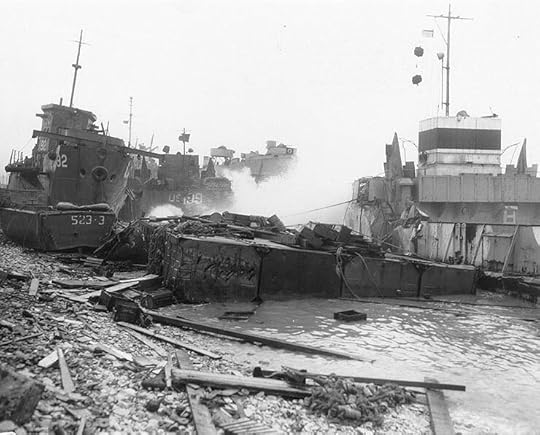
Broached landing craft during the Normandy storm, probably at Omaha Beach, 21 June 1944; USS LST-543 in background (US National Archives: SC 193919)
The post Today in World War II History—June 19, 1944 first appeared on Sarah Sundin.June 18, 2024
Today in World War II History—June 18, 1944

US Marine First Sgt. Neil Shober feeding bananas to a native goat, Saipan, Mariana Islands, June 1944 (US Marine Corps photo)
80 Years Ago—June 18, 1944: German V-1 buzz bomb hits the Guards Chapel in London during a service, killing 121.
Ivanoe Bonomi replaces Pietro Badoglio as Prime Minister of Italy.
On Saipan, US Marines drive to the east coast, cutting the island in two, while Army forces take Aslito AF, later renamed Isley Field.
Japanese take Changsha, China, in drive to open a land corridor to Hanoi in French Indochina.
The post Today in World War II History—June 18, 1944 first appeared on Sarah Sundin.June 17, 2024
Army Nursing in World War II – Who Could Serve

During World War II, members of the US Army Nurse Corps took care of the sick and wounded throughout the world, often in dangerous and difficult conditions. These brave women inspired four of my novels (A Memory Between Us and the Wings of the Nightingale series), so I’m sharing a four-part series on US Army nursing during the war.
Part 1: Who Could Serve in the US Army Nurse Corps
Part 2: Recruitment, Training, and Military Rank
Part 3: Uniforms
Part 4: General Nursing Practice
During World War II, 57,000 women served in the US Army Nurse Corps (ANC), 11,000 in the US Navy Nurse Corps (NNC), and 6500 in the US Army Air Forces. More than two hundred nurses died serving their country.
Who Could Serve in the US Army Nurse CorpsRequirementsTo serve in the Army Nurse Corps, women had to be 21-40 years old (raised to 45 later in the war), unmarried (married nurses were accepted starting in October 1942), a high school graduate, a graduate of a 3-year nursing training program, licensed in at least one state, a US citizen or a citizen of an Allied country, 5’0”-6’0,” have a physician’s certificate of health and a letter testifying to moral and professional excellence.
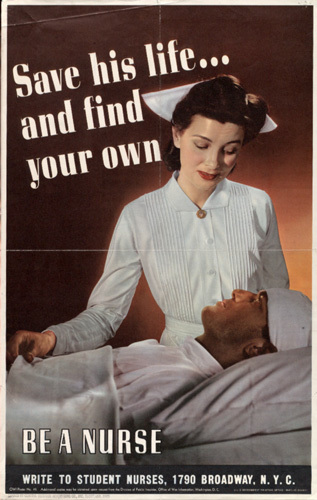
US poster, WWII
DischargePregnancy was the main cause of discharge from the Army Nurse Corps, or as the women called it, PWOP (Pregnant WithOut Permission). To discourage pregnancy, the Army had a cumbersome process to gain approval for marriage. In further precautions, the Army discouraged drinking, encouraged the women to socialize in groups, and took care with the location of nurses’ quarters. The second main reason for discharge was “neuropsychiatric,” also called combat fatigue (now called post-traumatic stress disorder).

US Army Nurse Corps recruiting poster, 1945
DiscriminationDiscrimination based on gender and race was rampant in the 1940s. Male nurses were not allowed in the ANC during World War II, just as female physicians were not admitted to the Medical Corps. In October 1940, a small quota of African-American nurses were admitted to the ANC. Despite a large number of Black registered nurses in the United States, fewer than five hundred were allowed to serve, and then only to care for Black patients or for prisoners of war. In July 1944, the Army removed this quota limiting the number of Black nurses who could serve.
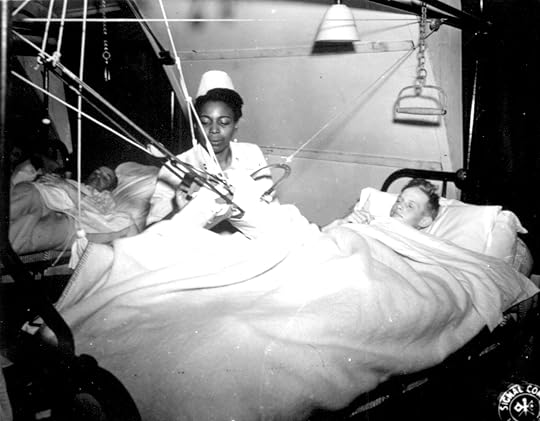
African-American US Army nurse Lt; Florie E. Gant tending a prisoner-of-war patient, England, 7 Oct 1944 (US National Archives: 112-SGA-Nurses-44-1676)
Sources:Sarnecky, Mary T.A. History of the U.S. Army Nurse Corps. Philadelphia: University of Pennsylvania Press, 1999. (A comprehensive history with a thick section on WWII).
Tomblin, Barbara Brooks. G.I. Nightingales: the Army Nurse Corps in World War II. Lexington: University Press of Kentucky, 1996. (A wonderful history, including all theaters, full of personal stories).
The post Army Nursing in World War II – Who Could Serve first appeared on Sarah Sundin.Today in World War II History—June 17, 1944

Flag of Iceland
80 Years Ago—June 17, 1944: In Normandy, US First Army cuts off the Cotentin Peninsula, trapping Germans in Cherbourg.
Free French troops land on Elba off the coast of Italy.
Iceland becomes an independent republic with Sveinn Björnsson as the first president.
The post Today in World War II History—June 17, 1944 first appeared on Sarah Sundin.June 16, 2024
Today in World War II History—June 16, 1944
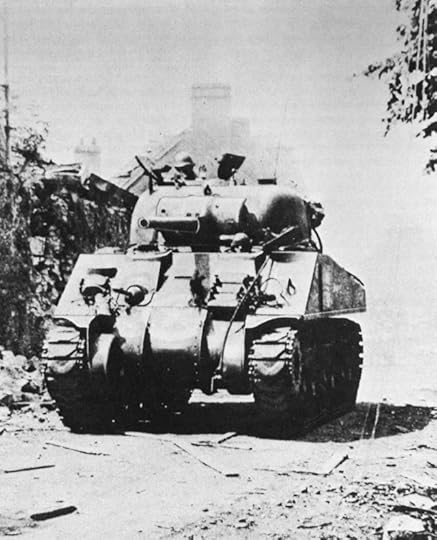
Tank of Company A of the 746th Tank Battalion supported the 325th Glider Infantry entering St. Sauveur-Le Vicomte, France, 16 June 1944 (US Army Center of Military History)
80 Years Ago—June 16, 1944: In drive across the Cotentin Peninsula in Normandy, US First Army takes Ste. Colombe and St. Sauveur-le-Vicomte.
US Navy Seabees finish the first pier of Mulberry A harbor at St. Laurent-sur-Mer off Omaha Beach and the first ship unloads; Mulberry B at Arromanches in the British sector opens two more piers.
US Army 27th Infantry Division lands on Saipan, joining the Marines who landed the day before.
The post Today in World War II History—June 16, 1944 first appeared on Sarah Sundin.June 15, 2024
Today in World War II History—June 15, 1944

US troops landing on Saipan, 15 June 1944 (US Army Center of Military History)
80 Years Ago—June 15, 1944: US Marine 2nd and 4th Divisions land on Saipan in the Mariana Islands.
US B-29 Superfortress bombers fly first mission to Japan, to Yawata steel works on Kyushu.
The post Today in World War II History—June 15, 1944 first appeared on Sarah Sundin.June 14, 2024
Hospitalization in World War II – Evacuation of the Wounded
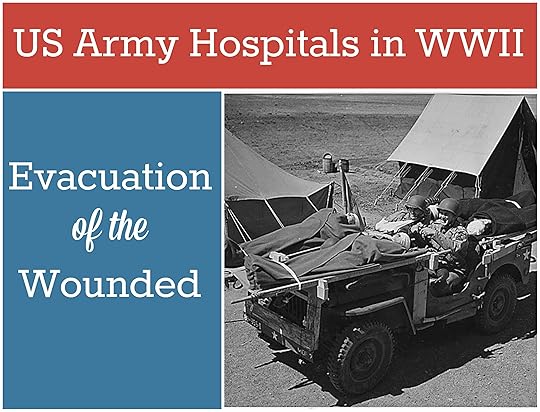
Photo: Jeep ambulance at Camp Carson, CO, 24 Apr 1943 (US National Archives: ARC 197176)
Unlike the US Fifth Army, Hutch crossed the Volturno River backward. While the Allies crossed under machine-gun fire eleven days earlier, Hutch rode in a jeep, turned in the front seat to face little Lucia. Her litter was strapped across the backseat, while two more litters were strapped on the hood.
A furrow raced up Lucia’s forehead, and she clutched her doll even tighter.
Time for Hutch’s treat. “I have a gift for you. For Lucia.” (On Distant Shores, p. 194)
In my novel On Distant Shores, the hero serves as a pharmacist in an evacuation hospital and the heroine serves as a flight nurse. This article is the second in a three-part series on US Army hospitalization in World War II.
Part 1: Chain of Evacuation
Part 2: Mobile and Fixed Hospitals
Part 3: Evacuation of the Wounded
Evacuation of the WoundedManual TransportOn the battlefield, medics or fellow soldiers could manually carry a wounded man further to the rear for aid. Methods included the supporting carry (walking side-by-side), the arms carry, the saddleback carry (piggy-back), and the fireman’s carry.
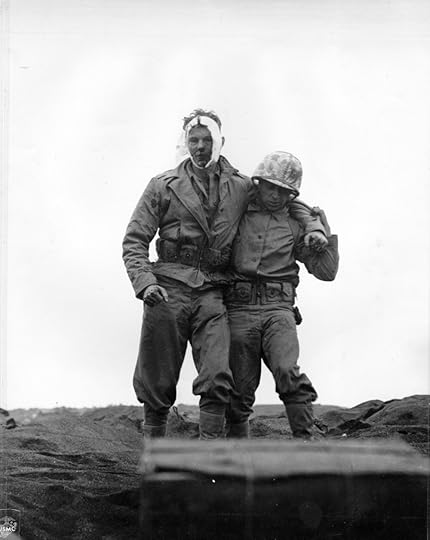
Wounded US Marine being helped by a comrade, Iwo Jima, 20 Feb 1945 (US Marine Corps photo)
Litter TransportAmerican litters were made of canvas stretched over aluminum or wood poles with stirrup-shaped feet to keep them off the ground. A litter could be carried by two people, but a litter squad consisted of four men, to rotate if traveling long distances and to assist over obstacles. Ideally, litter transport was only used for short distances, but in mountainous or forested or swampy terrain, litter transport was the only available means. Mules were often used in the Mediterranean Theater to carry litters in rocky, mountainous terrain.
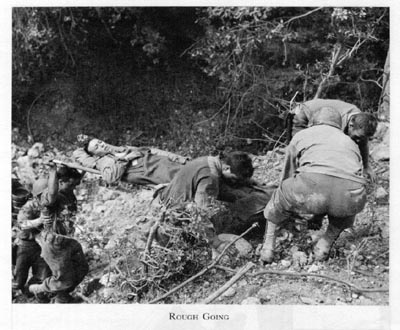
Litter-bearers in Italy’s mountains, WWII (US Army Medical Dept.)
Motor TransportAmbulances were used to transport patients, usually from an aid, clearing, or collecting station to a field hospital, or for transport further to the rear. Ambulances could carry seven seated patients or four patients on litters.
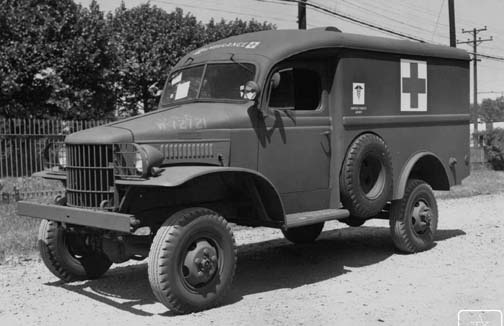
Dodge WC9 1/2 ton ambulance, 15 May 1941 (US National Archives)
Jeeps were often used, both on the battleground and to transport further to the rear. Rugged and maneuverable, jeeps could cover terrain inaccessible to ambulances. With litter brackets, a jeep could carry two or three patients. Armored divisions also used light tanks to transport their wounded.
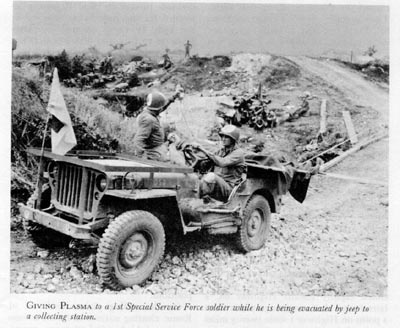
US medics administer plasma to a patient in a jeep ambulance, Italy, 1944 (US Army Medical Dept.)
Water TransportDuring an amphibious landing, the best way to handle the wounded was to send them back on departing landing craft, which carried them to transports or hospital ships off-shore. Patients could be removed from danger and transported quickly to get needed care.
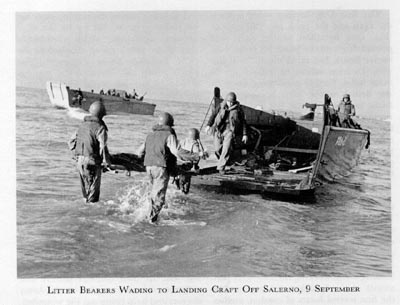
Wounded American soldiers being evacuated by landing craft (LCVP) off Salerno, Italy, 9 September 1943. (US Army Medical Dept.)
Hospital ships were used offshore after an invasion to care for the wounded before field and evacuation hospitals could be set up. They also transported patients who needed long-term care to general hospitals further to the rear. Another use of hospital ships was to transport to the US any patients who needed long-term convalescent care or those who qualified for a medical discharge. They carried several hundred patients and delivered full medical care, but transport took a long time and carried the danger of enemy attack at sea, even when marked with the Red Cross.
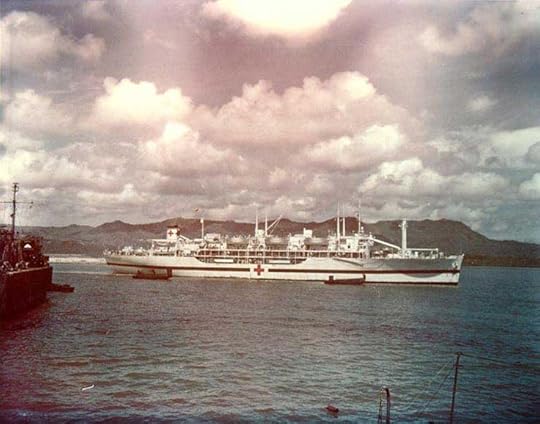
Hospital ship USS Tranquility arriving at Guam with survivors of sinking of USS Indianapolis, 8 Aug 1945. (US National Archives: 80-G-K-5979)
Rail TransportHospital trains were used within theaters of operation to transport patients from one hospital to another. They were used in the continental US, Britain, continental Europe, India, and North Africa. They could carry several hundred patients and provide excellent medical care.
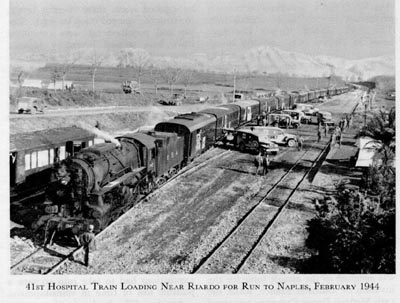
US 41st Hospital Train running from the Italian front to the Army hospital complex in Naples, February 1944 (US Army Medical Dept.)
Air TransportMedical air evacuation was new and revolutionary, but by the end of the war, it proved successful. Planes can traverse inhospitable terrain or dangerous seas—and quickly. C-47 cargo planes carried 18-24 litter patients or a higher number of ambulatory patients. A team consisting of a flight nurse and a surgical technician cared for the patients in flight. The larger C-54 cargo plane was used for trans-oceanic evacuation. Danger still existed, both from the inherent risks of flight and also because the planes carried cargo, couldn’t be marked with the Red Cross, and were legitimate military targets.
Read more in my blog series: Medical Air Evacuation in World War II.
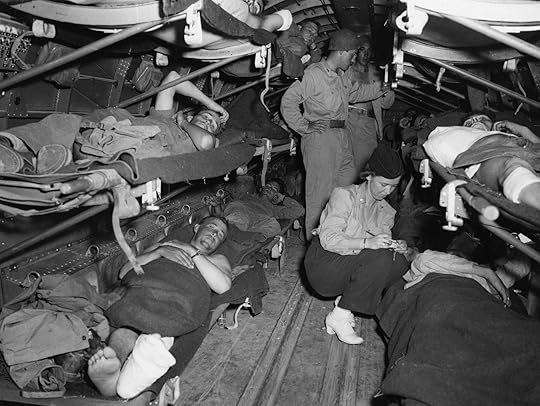
Lt. Katye Swope of the 802nd Medical Air Evacuation Transport Squadron checks patients being evacuated from Agrigento, Sicily to North Africa for further medical treatment, 25 July 1943 (US Air Force photo 25749AC)
ResourcesOffice of the Surgeon General. Medical Field Manual: Transportation of the Sick and Wounded. Washington, DC: US Government Printing Office, Feb. 21, 1941. Please note the date—some of the material, especially about air evacuation, became quickly outdated.
For better information on air evacuation, please see:
Links, Mae Mills & Coleman, Hubert A. Medical Support of the Army Air Forces in World War II. Washington, D.C.: Office of the Surgeon General, USAF, 1955.
The post Hospitalization in World War II – Evacuation of the Wounded first appeared on Sarah Sundin.


